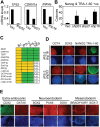Senescence impairs successful reprogramming to pluripotent stem cells
- PMID: 19696146
- PMCID: PMC2751980
- DOI: 10.1101/gad.1811609
Senescence impairs successful reprogramming to pluripotent stem cells
Abstract
Somatic cells can be reprogrammed into induced pluripotent stem (iPS) cells by overexpressing combinations of factors such as Oct4, Sox2, Klf4, and c-Myc. Reprogramming is slow and stochastic, suggesting the existence of barriers limiting its efficiency. Here we identify senescence as one such barrier. Expression of the four reprogramming factors triggers senescence by up-regulating p53, p16(INK4a), and p21(CIP1). Induction of DNA damage response and chromatin remodeling of the INK4a/ARF locus are two of the mechanisms behind senescence induction. Crucially, ablation of different senescence effectors improves the efficiency of reprogramming, suggesting novel strategies for maximizing the generation of iPS cells.
Figures





References
Publication types
MeSH terms
Grants and funding
LinkOut - more resources
Full Text Sources
Other Literature Sources
Research Materials
Miscellaneous
